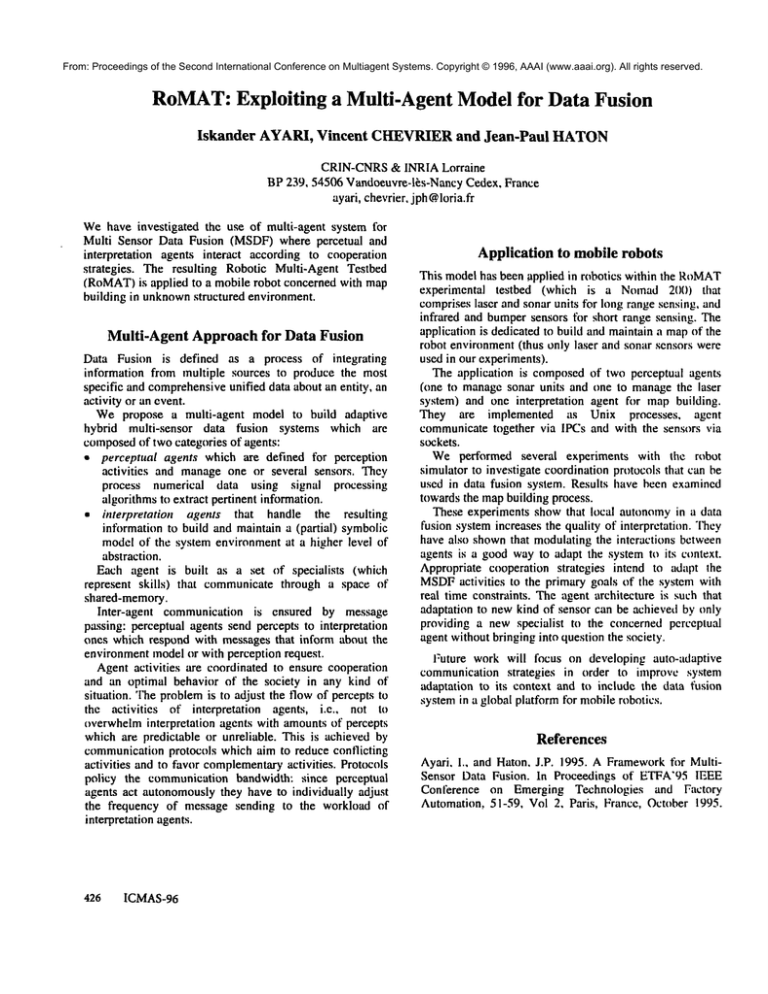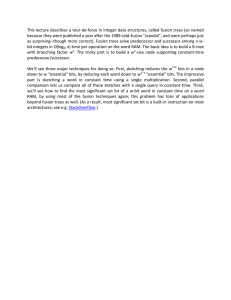
From: Proceedings of the Second International Conference on Multiagent Systems. Copyright © 1996, AAAI (www.aaai.org). All rights reserved.
RoMAT:
Exploiting a Multi-Agent Model for Data Fusion
Iskander AYARI, Vincent CHEVRIER
and Jean-Paul HATON
CRIN-CNRS& INRIA Lorraine
BP 239, 54506 Vandoeuvre-l~:s-Nancy Cedex, France
ayari, chevrier, jph @loria.fr
Wehave investigated the use of multi-agent system for
Multi Sensor Data Fusion (MSDF)where percetual and
interpretation agents interact according to cooperation
strategies. The resulting Robotic Multi-Agent Testbed
(RoMAT)
is applied to a mobile robot concerned with map
building in unknownstructured environment.
Multi-Agent Approachfor Data Fusion
Data Fusion is defined as a process of integrating
information from multiple sources to produce the most
specific and comprehensiveunified data about an entity, an
activity or an event.
We propose a multi-agent model to build adaptive
hybrid multi-sensor data fusion systems which are
composedof two categories of agents:
¯ perceptual agents which are defined for perception
activities and manageone or several sensors. They
processing
process numerical data using sign;d
algorithmsto extract pertinent information.
¯ interpretation
agents that handle the resulting
information to build and maintain a (partial) symbolic
model of the system environment at a higher level of
abstraction.
Each agent is built as a set of specialists (which
represent skills) that communicatethrough a space of
shared-memory.
Inter-agent
communication is ensured by message
passing: perceptual agents send percepts to interpretation
ones which respond with messages that inform about the
environmentmodel or with perception request.
Agent activities are coordinated to ensure cooperation
and an optimal behavior of the society in any kind of
situation. The problemis to adjust the flow of percepts to
the activities of interpretation agents, i.e., not to
overwhelminterpretation agents with amountsof percepts
which are predictable or unreliable. This is achieved by
communicationprotocols which aim to reduce conflicting
activities and to favor complementary
activities. Protocols
policy the communication bandwidth: since perceptual
agents act autonomouslythey have to individually adjust
the frequency of message sending to the workload of
interpretation agents.
426
ICMAS-96
Application to mobile robots
This model has been applied in robotics within the RoMAT
experimental testbed (which is a Nomad200) that
comprises laser and sonar units for long range sensing, and
infrared and bumpersensors for short range sensing. The
application is dedicated to build and maintain a mapof the
robot environment(thus only laser and sonar sensors were
used in our experiments).
The application is composedof two perceptual agents
(one to managesonar units and one to managethe laser
system) and one interpretation agent for mapbuilding.
They are implemented as Unix processes,
agent
communicatetogether via IPCs and with the sensors via
sockets.
We performed several experiments with the robot
simulator to investigate coordination protocols that can be
used in data fusion system. Results have been examined
towards the mapbuilding process.
These experiments show that local autonomyin a data
fusion systemincreases the quality of interpretation. They
have also shownthat modulating the interactions between
agents is a good way to adapt the system to its context.
Appropriate cooperation strategies intend to adapt lhe
MSDF
activities to the primary goals of the system with
real time constraints. The agent architecture is such that
adaptation to newkind of sensor can be achievetl by only
providing a new specialist to the concerned perceptual
agent without bringing into question the society.
Future work will focus on developing auto-adaptive
communication strategies in order to improve system
adaptation to its context and to include the data fusion
systemin a global platform for mobilerobotics.
References
Ayari, 1., and Haton, J.P. 1995. A Frameworkfor MultiSensor Data Fusion. In Proceedings of ETFA’95IEEE
Conference on Emerging Technologies and Factory
Automation, 51-59, Vol 2, Paris, France, October 1995.




